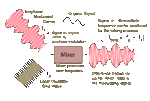tony_lth
Advanced Member level 5

HI,
I am confused about the beat signal of the radar when I read some IEEE papers.
I have the following questions:
1. What is the purpose of the beat signal? To avoid flicker noise?
2. Beat signal only fit for LFMCW radar?
3. How to conduct beat signal in Radar? Is it the 1/T, T is the period of the waveform?
4. Based FFT, range resolution is by Delta(R)=C/2.B, it seems beat signal has no relation with Delta(R), right?
That is all I can think,
Thanks for your help.
I am confused about the beat signal of the radar when I read some IEEE papers.
I have the following questions:
1. What is the purpose of the beat signal? To avoid flicker noise?
2. Beat signal only fit for LFMCW radar?
3. How to conduct beat signal in Radar? Is it the 1/T, T is the period of the waveform?
4. Based FFT, range resolution is by Delta(R)=C/2.B, it seems beat signal has no relation with Delta(R), right?
That is all I can think,
Thanks for your help.


